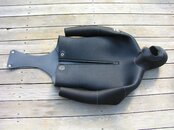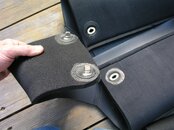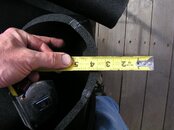Eric Sedletzky
Contributor
M&B wetsuits in Long Beach, CA can make any vintage style wetsuit you want.
Don has the original patterns from the late 50's for beaver tail wetsuits, pants, pointy hoods, anything you want. His pointy hood pattern is the exact same pattern that was used to make the hoods for the Sea Hunt show. He even has original nickel zippers from that era, not reproduction zippers, the ACTUAL zippers that have been sitting in a drawer for years.
He can make skin both sides suits too if that's what you want.
Don't expect cheap though, the dude has to make a living and there's no way he can match chinese worker $2.00 a day prices. His suits start about $500 but they are worth every penny and they are custom fit to you.
Don just called me the other day and wondered why more vintage suit oficionados haven't called him. I said I don't know, I've tried to spread the word but you know how it is talk is cheap.
If you want a true classic new vintage style suit this is the place to get it.
M&B Wetsuits (562) 422-3493
Before anybody says anything, I'm not affiliated with M&B in any way and gain nothing for my plugs except maybe a little insurance that he'll remain in business so I can continue to get great suits.
Here are a couple pics of a classic beaver tail commercial urchin suit he made for me.:
Don has the original patterns from the late 50's for beaver tail wetsuits, pants, pointy hoods, anything you want. His pointy hood pattern is the exact same pattern that was used to make the hoods for the Sea Hunt show. He even has original nickel zippers from that era, not reproduction zippers, the ACTUAL zippers that have been sitting in a drawer for years.
He can make skin both sides suits too if that's what you want.
Don't expect cheap though, the dude has to make a living and there's no way he can match chinese worker $2.00 a day prices. His suits start about $500 but they are worth every penny and they are custom fit to you.
Don just called me the other day and wondered why more vintage suit oficionados haven't called him. I said I don't know, I've tried to spread the word but you know how it is talk is cheap.
If you want a true classic new vintage style suit this is the place to get it.
M&B Wetsuits (562) 422-3493
Before anybody says anything, I'm not affiliated with M&B in any way and gain nothing for my plugs except maybe a little insurance that he'll remain in business so I can continue to get great suits.
Here are a couple pics of a classic beaver tail commercial urchin suit he made for me.:
Attachments
Last edited by a moderator:








